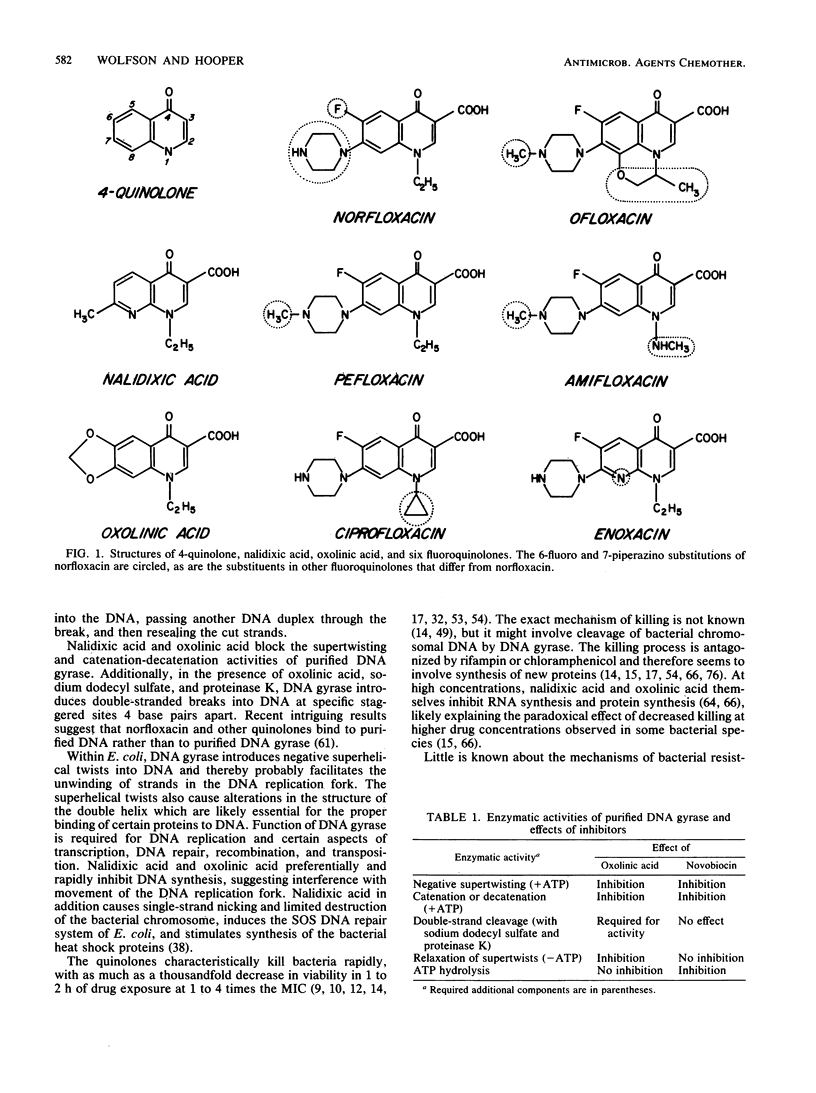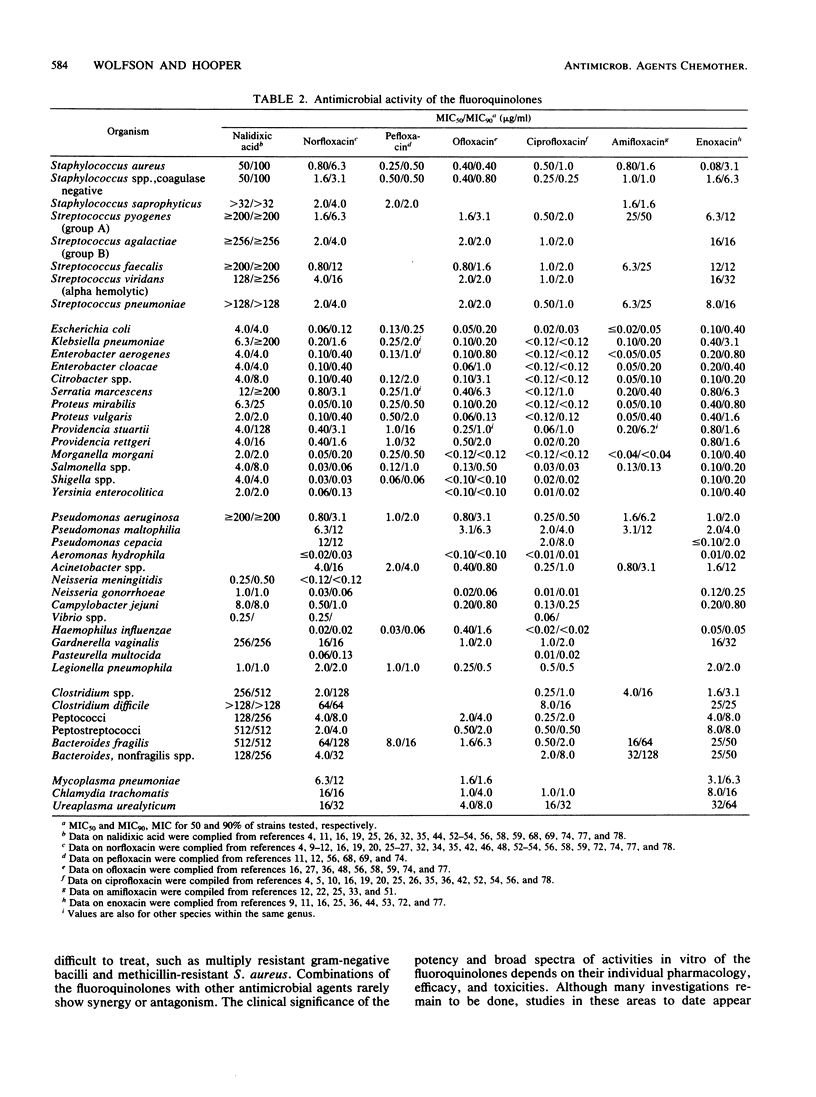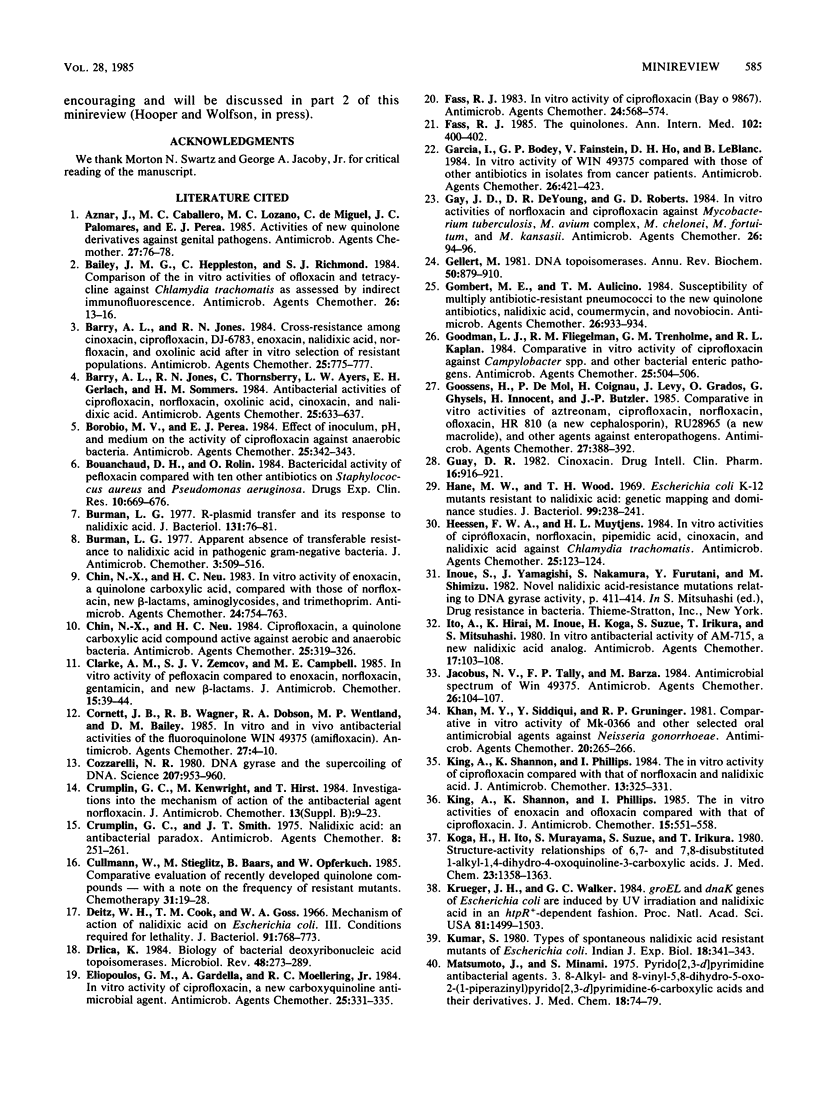Full text
PDF





Selected References
These references are in PubMed. This may not be the complete list of references from this article.
- Aznar J., Caballero M. C., Lozano M. C., de Miguel C., Palomares J. C., Perea E. J. Activities of new quinoline derivatives against genital pathogens. Antimicrob Agents Chemother. 1985 Jan;27(1):76–78. doi: 10.1128/aac.27.1.76. [DOI] [PMC free article] [PubMed] [Google Scholar]
- Bailey J. M., Heppleston C., Richmond S. J. Comparison of the in vitro activities of ofloxacin and tetracycline against Chlamydia trachomatis as assessed by indirect immunofluorescence. Antimicrob Agents Chemother. 1984 Jul;26(1):13–16. doi: 10.1128/aac.26.1.13. [DOI] [PMC free article] [PubMed] [Google Scholar]
- Barry A. L., Jones R. N. Cross-resistance among cinoxacin, ciprofloxacin, DJ-6783, enoxacin, nalidixic acid, norfloxacin, and oxolinic acid after in vitro selection of resistant populations. Antimicrob Agents Chemother. 1984 Jun;25(6):775–777. doi: 10.1128/aac.25.6.775. [DOI] [PMC free article] [PubMed] [Google Scholar]
- Barry A. L., Jones R. N., Thornsberry C., Ayers L. W., Gerlach E. H., Sommers H. M. Antibacterial activities of ciprofloxacin, norfloxacin, oxolinic acid, cinoxacin, and nalidixic acid. Antimicrob Agents Chemother. 1984 May;25(5):633–637. doi: 10.1128/aac.25.5.633. [DOI] [PMC free article] [PubMed] [Google Scholar]
- Borobio M. V., Perea E. J. Effect of inoculum, pH, and medium on the activity of ciprofloxacin against anaerobic bacteria. Antimicrob Agents Chemother. 1984 Mar;25(3):342–343. doi: 10.1128/aac.25.3.342. [DOI] [PMC free article] [PubMed] [Google Scholar]
- Burman L. G. Apparent absence of transferable resistance to nalidixic acid in pathogenic Gram-negative bacteria. J Antimicrob Chemother. 1977 Sep;3(5):509–516. doi: 10.1093/jac/3.5.509. [DOI] [PubMed] [Google Scholar]
- Burman L. G. R-plasmid transfer and its response to nalidixic acid. J Bacteriol. 1977 Jul;131(1):76–81. doi: 10.1128/jb.131.1.76-81.1977. [DOI] [PMC free article] [PubMed] [Google Scholar]
- Chin N. X., Neu H. C. Ciprofloxacin, a quinolone carboxylic acid compound active against aerobic and anaerobic bacteria. Antimicrob Agents Chemother. 1984 Mar;25(3):319–326. doi: 10.1128/aac.25.3.319. [DOI] [PMC free article] [PubMed] [Google Scholar]
- Chin N. X., Neu H. C. In vitro activity of enoxacin, a quinolone carboxylic acid, compared with those of norfloxacin, new beta-lactams, aminoglycosides, and trimethoprim. Antimicrob Agents Chemother. 1983 Nov;24(5):754–763. doi: 10.1128/aac.24.5.754. [DOI] [PMC free article] [PubMed] [Google Scholar]
- Clarke A. M., Zemcov S. J., Campbell M. E. In-vitro activity of pefloxacin compared to enoxacin, norfloxacin, gentamicin and new beta-lactams. J Antimicrob Chemother. 1985 Jan;15(1):39–44. doi: 10.1093/jac/15.1.39. [DOI] [PubMed] [Google Scholar]
- Cornett J. B., Wagner R. B., Dobson R. A., Wentland M. P., Bailey D. M. In vitro and in vivo antibacterial activities of the fluoroquinolone WIN 49375 (amifloxacin). Antimicrob Agents Chemother. 1985 Jan;27(1):4–10. doi: 10.1128/aac.27.1.4. [DOI] [PMC free article] [PubMed] [Google Scholar]
- Cozzarelli N. R. DNA gyrase and the supercoiling of DNA. Science. 1980 Feb 29;207(4434):953–960. doi: 10.1126/science.6243420. [DOI] [PubMed] [Google Scholar]
- Crumplin G. C., Kenwright M., Hirst T. Investigations into the mechanism of action of the antibacterial agent norfloxacin. J Antimicrob Chemother. 1984 May;13 (Suppl B):9–23. doi: 10.1093/jac/13.suppl_b.9. [DOI] [PubMed] [Google Scholar]
- Crumplin G. C., Smith J. T. Nalidixic acid: an antibacterial paradox. Antimicrob Agents Chemother. 1975 Sep;8(3):251–261. doi: 10.1128/aac.8.3.251. [DOI] [PMC free article] [PubMed] [Google Scholar]
- Cullmann W., Stieglitz M., Baars B., Opferkuch W. Comparative evaluation of recently developed quinolone compounds--with a note on the frequency of resistant mutants. Chemotherapy. 1985;31(1):19–28. doi: 10.1159/000238309. [DOI] [PubMed] [Google Scholar]
- Deitz W. H., Cook T. M., Goss W. A. Mechanism of action of nalidixic acid on Escherichia coli. 3. Conditions required for lethality. J Bacteriol. 1966 Feb;91(2):768–773. doi: 10.1128/jb.91.2.768-773.1966. [DOI] [PMC free article] [PubMed] [Google Scholar]
- Drlica K. Biology of bacterial deoxyribonucleic acid topoisomerases. Microbiol Rev. 1984 Dec;48(4):273–289. doi: 10.1128/mr.48.4.273-289.1984. [DOI] [PMC free article] [PubMed] [Google Scholar]
- Eliopoulos G. M., Gardella A., Moellering R. C., Jr In vitro activity of ciprofloxacin, a new carboxyquinoline antimicrobial agent. Antimicrob Agents Chemother. 1984 Mar;25(3):331–335. doi: 10.1128/aac.25.3.331. [DOI] [PMC free article] [PubMed] [Google Scholar]
- Fass R. J. In vitro activity of ciprofloxacin (Bay o 9867). Antimicrob Agents Chemother. 1983 Oct;24(4):568–574. doi: 10.1128/aac.24.4.568. [DOI] [PMC free article] [PubMed] [Google Scholar]
- Fass R. J. The quinolones. Ann Intern Med. 1985 Mar;102(3):400–402. doi: 10.7326/0003-4819-102-3-400. [DOI] [PubMed] [Google Scholar]
- Garcia I., Bodey G. P., Fainstein V., Ho D. H., LeBlanc B. In vitro activity of WIN 49375 compared with those of other antibiotics in isolates from cancer patients. Antimicrob Agents Chemother. 1984 Sep;26(3):421–423. doi: 10.1128/aac.26.3.421. [DOI] [PMC free article] [PubMed] [Google Scholar]
- Gay J. D., DeYoung D. R., Roberts G. D. In vitro activities of norfloxacin and ciprofloxacin against Mycobacterium tuberculosis, M. avium complex, M. chelonei, M. fortuitum, and M. kansasii. Antimicrob Agents Chemother. 1984 Jul;26(1):94–96. doi: 10.1128/aac.26.1.94. [DOI] [PMC free article] [PubMed] [Google Scholar]
- Gellert M. DNA topoisomerases. Annu Rev Biochem. 1981;50:879–910. doi: 10.1146/annurev.bi.50.070181.004311. [DOI] [PubMed] [Google Scholar]
- Gombert M. E., Aulicino T. M. Susceptibility of multiply antibiotic-resistant pneumococci to the new quinoline antibiotics, nalidixic acid, coumermycin, and novobiocin. Antimicrob Agents Chemother. 1984 Dec;26(6):933–934. doi: 10.1128/aac.26.6.933. [DOI] [PMC free article] [PubMed] [Google Scholar]
- Goodman L. J., Fliegelman R. M., Trenholme G. M., Kaplan R. L. Comparative in vitro activity of ciprofloxacin against Campylobacter spp. and other bacterial enteric pathogens. Antimicrob Agents Chemother. 1984 Apr;25(4):504–506. doi: 10.1128/aac.25.4.504. [DOI] [PMC free article] [PubMed] [Google Scholar]
- Goossens H., De Mol P., Coignau H., Levy J., Grados O., Ghysels G., Innocent H., Butzler J. P. Comparative in vitro activities of aztreonam, ciprofloxacin, norfloxacin, ofloxacin, HR 810 (a new cephalosporin), RU28965 (a new macrolide), and other agents against enteropathogens. Antimicrob Agents Chemother. 1985 Mar;27(3):388–392. doi: 10.1128/aac.27.3.388. [DOI] [PMC free article] [PubMed] [Google Scholar]
- Guay D. R. Cinoxacin (Cinobac, Eli Lilly & Co.). Drug Intell Clin Pharm. 1982 Dec;16(12):916–921. doi: 10.1177/106002808201601203. [DOI] [PubMed] [Google Scholar]
- Hane M. W., Wood T. H. Escherichia coli K-12 mutants resistant to nalidixic acid: genetic mapping and dominance studies. J Bacteriol. 1969 Jul;99(1):238–241. doi: 10.1128/jb.99.1.238-241.1969. [DOI] [PMC free article] [PubMed] [Google Scholar]
- Heessen F. W., Muytjens H. L. In vitro activities of ciprofloxacin, norfloxacin, pipemidic acid, cinoxacin, and nalidixic acid against Chlamydia trachomatis. Antimicrob Agents Chemother. 1984 Jan;25(1):123–124. doi: 10.1128/aac.25.1.123. [DOI] [PMC free article] [PubMed] [Google Scholar]
- Ito A., Hirai K., Inoue M., Koga H., Suzue S., Irikura T., Mitsuhashi S. In vitro antibacterial activity of AM-715, a new nalidixic acid analog. Antimicrob Agents Chemother. 1980 Feb;17(2):103–108. doi: 10.1128/aac.17.2.103. [DOI] [PMC free article] [PubMed] [Google Scholar]
- Jacobus N. V., Tally F. P., Barza M. Antimicrobial spectrum of Win 49375. Antimicrob Agents Chemother. 1984 Jul;26(1):104–107. doi: 10.1128/aac.26.1.104. [DOI] [PMC free article] [PubMed] [Google Scholar]
- Khan M. Y., Siddiqui Y., Gruninger R. P. Comparative in vitro activity of Mk-0366 and other selected oral antimicrobial agents against Neisseria gonorrhoeae. Antimicrob Agents Chemother. 1981 Aug;20(2):265–266. doi: 10.1128/aac.20.2.265. [DOI] [PMC free article] [PubMed] [Google Scholar]
- King A., Shannon K., Phillips I. The in-vitro activities of enoxacin and ofloxacin compared with that of ciprofloxacin. J Antimicrob Chemother. 1985 May;15(5):551–558. doi: 10.1093/jac/15.5.551. [DOI] [PubMed] [Google Scholar]
- King A., Shannon K., Phillips I. The in-vitro activity of ciprofloxacin compared with that of norfloxacin and nalidixic acid. J Antimicrob Chemother. 1984 Apr;13(4):325–331. doi: 10.1093/jac/13.4.325. [DOI] [PubMed] [Google Scholar]
- Koga H., Itoh A., Murayama S., Suzue S., Irikura T. Structure-activity relationships of antibacterial 6,7- and 7,8-disubstituted 1-alkyl-1,4-dihydro-4-oxoquinoline-3-carboxylic acids. J Med Chem. 1980 Dec;23(12):1358–1363. doi: 10.1021/jm00186a014. [DOI] [PubMed] [Google Scholar]
- Krueger J. H., Walker G. C. groEL and dnaK genes of Escherichia coli are induced by UV irradiation and nalidixic acid in an htpR+-dependent fashion. Proc Natl Acad Sci U S A. 1984 Mar;81(5):1499–1503. doi: 10.1073/pnas.81.5.1499. [DOI] [PMC free article] [PubMed] [Google Scholar]
- Kumar S. Types of spontaneous nalidixic acid resistant mutants of Escherichia coli. Indian J Exp Biol. 1980 Apr;18(4):341–343. [PubMed] [Google Scholar]
- Matsumoto J., Minami S. Pyrido(2,3-d)pyrimidine antibacterial agents. 3. 8-Alkyl- and 8-vinyl-5,8-dihydro-5-oxo-2-(1-piperazinyl)pyrido(2,3-d)pyrimidine-6-carboxylic acids and their derivatives. J Med Chem. 1975 Jan;18(1):74–79. doi: 10.1021/jm00235a017. [DOI] [PubMed] [Google Scholar]
- Matsumoto J., Miyamoto T., Minamida A., Nishimura Y., Egawa H., Nishimura H. Pyridonecarboxylic acids as antibacterial agents. 2. Synthesis and structure-activity relationships of 1,6,7-trisubstituted 1,4-dihydro-4-oxo-1,8-naphthyridine-3-carboxylic acids, including enoxacin, a new antibacterial agent. J Med Chem. 1984 Mar;27(3):292–301. doi: 10.1021/jm00369a011. [DOI] [PubMed] [Google Scholar]
- Muytjens H. L., van der Ros-van de Repe J., van Veldhuizen G. Comparative activities of ciprofloxacin (Bay o 9867), norfloxacin, pipemidic acid, and nalidixic acid. Antimicrob Agents Chemother. 1983 Aug;24(2):302–304. doi: 10.1128/aac.24.2.302. [DOI] [PMC free article] [PubMed] [Google Scholar]
- Nakamura S., Inoue S., Shimizu M., Iyobe S., Mitsuhashi S. Inhibition of conjugal transfer of R plasmids by pipemidic acid and related compounds. Antimicrob Agents Chemother. 1976 Nov;10(5):779–785. doi: 10.1128/aac.10.5.779. [DOI] [PMC free article] [PubMed] [Google Scholar]
- Nakamura S., Minami A., Katae H., Inoue S., Yamagishi J., Takase Y., Shimizu M. In vitro antibacterial properties of AT-2266, a new pyridonecarboxylic acid. Antimicrob Agents Chemother. 1983 May;23(5):641–648. doi: 10.1128/aac.23.5.641. [DOI] [PMC free article] [PubMed] [Google Scholar]
- Neu H. C., Chin N. X., Labthavikul P. Antibacterial activity of coumermycin alone and in combination with other antibiotics. Antimicrob Agents Chemother. 1984 Jun;25(6):687–689. doi: 10.1128/aac.25.6.687. [DOI] [PMC free article] [PubMed] [Google Scholar]
- Neu H. C., Labthavikul P. In vitro activity of norfloxacin, a quinolinecarboxylic acid, compared with that of beta-lactams, aminoglycosides, and trimethoprim. Antimicrob Agents Chemother. 1982 Jul;22(1):23–27. doi: 10.1128/aac.22.1.23. [DOI] [PMC free article] [PubMed] [Google Scholar]
- Osada Y., Ogawa H. Antimycoplasmal activity of ofloxacin (DL-8280). Antimicrob Agents Chemother. 1983 Mar;23(3):509–511. doi: 10.1128/aac.23.3.509. [DOI] [PMC free article] [PubMed] [Google Scholar]
- Peeters M., Van Dyck E., Piot P. In vitro activities of the spectinomycin analog U-63366 and four quinolone derivatives against Neisseria gonorrhoeae. Antimicrob Agents Chemother. 1984 Oct;26(4):608–609. doi: 10.1128/aac.26.4.608. [DOI] [PMC free article] [PubMed] [Google Scholar]
- Piffaretti J. C., Demarta A., Leidi-Bulla L., Peduzzi R. In vitro emergence of Escherichia coli and Pseudomonas aeruginosa strains resistant to norfloxacin and nalidixic acid. Eur J Clin Microbiol. 1983 Dec;2(6):600–601. doi: 10.1007/BF02016577. [DOI] [PubMed] [Google Scholar]
- Pohlod D. J., Saravolatz L. D. In vitro susceptibilities of 393 recent clinical isolates to WIN 49375, cefotaxime, tobramycin, and piperacillin. Antimicrob Agents Chemother. 1984 Mar;25(3):377–379. doi: 10.1128/aac.25.3.377. [DOI] [PMC free article] [PubMed] [Google Scholar]
- Prabhala R. H., Rao B., Marshall R., Bansal M. B., Thadepalli H. In vitro susceptibility of anaerobic bacteria to ciprofloxacin (Bay o 9867). Antimicrob Agents Chemother. 1984 Nov;26(5):785–786. doi: 10.1128/aac.26.5.785. [DOI] [PMC free article] [PubMed] [Google Scholar]
- Reeves D. S., Bywater M. J., Holt H. A. The activity of enoxacin against clinical bacterial isolates in comparison with that of five other agents, and factors affecting that activity. J Antimicrob Chemother. 1984 Sep;14 (Suppl 100):7–17. doi: 10.1093/jac/14.suppl_c.7. [DOI] [PubMed] [Google Scholar]
- Reeves D. S., Bywater M. J., Holt H. A., White L. O. In-vitro studies with ciprofloxacin, a new 4-quinolone compound. J Antimicrob Chemother. 1984 Apr;13(4):333–346. doi: 10.1093/jac/13.4.333. [DOI] [PubMed] [Google Scholar]
- Rella M., Haas D. Resistance of Pseudomonas aeruginosa PAO to nalidixic acid and low levels of beta-lactam antibiotics: mapping of chromosomal genes. Antimicrob Agents Chemother. 1982 Aug;22(2):242–249. doi: 10.1128/aac.22.2.242. [DOI] [PMC free article] [PubMed] [Google Scholar]
- Ruckdeschel G., Ehret W., Ahl A. Susceptibility of Legionella spp. to quinolone derivatives and related organic acids. Eur J Clin Microbiol. 1984 Aug;3(4):373–373. doi: 10.1007/BF01977502. [DOI] [PubMed] [Google Scholar]
- Sanders C. C., Sanders W. E., Jr, Goering R. V., Werner V. Selection of multiple antibiotic resistance by quinolones, beta-lactams, and aminoglycosides with special reference to cross-resistance between unrelated drug classes. Antimicrob Agents Chemother. 1984 Dec;26(6):797–801. doi: 10.1128/aac.26.6.797. [DOI] [PMC free article] [PubMed] [Google Scholar]
- Sato K., Matsuura Y., Inoue M., Une T., Osada Y., Ogawa H., Mitsuhashi S. In vitro and in vivo activity of DL-8280, a new oxazine derivative. Antimicrob Agents Chemother. 1982 Oct;22(4):548–553. doi: 10.1128/aac.22.4.548. [DOI] [PMC free article] [PubMed] [Google Scholar]
- Seibert G., Limbert M., Klesel N. Comparison of the antibacterial in vitro and in vivo activity of ofloxacin (HOE 280 DL 8280) and nalidixic acid analogues. Eur J Clin Microbiol. 1983 Dec;2(6):548–553. doi: 10.1007/BF02016563. [DOI] [PubMed] [Google Scholar]
- Shah P. M., Ottrad M., Stille W. In vitro activity of norfloxacin in urine compared to that of cinnoxacin, nalidixic acid and pipemidic acid. Eur J Clin Microbiol. 1983 Jun;2(3):272–274. doi: 10.1007/BF02029533. [DOI] [PubMed] [Google Scholar]
- Shen L. L., Pernet A. G. Mechanism of inhibition of DNA gyrase by analogues of nalidixic acid: the target of the drugs is DNA. Proc Natl Acad Sci U S A. 1985 Jan;82(2):307–311. doi: 10.1073/pnas.82.2.307. [DOI] [PMC free article] [PubMed] [Google Scholar]
- Simon C., Lindner U. In vitro activity of norfloxacin against Mycoplasma hominis and Ureaplasma urealyticum. Eur J Clin Microbiol. 1983 Oct;2(5):479–480. doi: 10.1007/BF02013911. [DOI] [PubMed] [Google Scholar]
- Sisca T. S., Heel R. C., Romankiewicz J. A. Cinoxacin. A review of its pharmacological properties and therapeutic efficacy in the treatment of urinary tract infections. Drugs. 1983 Jun;25(6):544–569. doi: 10.2165/00003495-198325060-00002. [DOI] [PubMed] [Google Scholar]
- Smith G. R. DNA supercoiling: another level for regulating gene expression. Cell. 1981 Jun;24(3):599–600. doi: 10.1016/0092-8674(81)90085-4. [DOI] [PubMed] [Google Scholar]
- Smith J. T. Mutational resistance to 4-quinolone antibacterial agents. Eur J Clin Microbiol. 1984 Aug;3(4):347–350. doi: 10.1007/BF01977492. [DOI] [PubMed] [Google Scholar]
- Stevens P. J. Bactericidal effect against Escherichia coli of nalidixic acid and four structurally related compounds. J Antimicrob Chemother. 1980 Jul;6(4):535–542. doi: 10.1093/jac/6.4.535. [DOI] [PubMed] [Google Scholar]
- Tenney J. H., Maack R. W., Chippendale G. R. Rapid selection of organisms with increasing resistance on subinhibitory concentrations of norfloxacin in agar. Antimicrob Agents Chemother. 1983 Jan;23(1):188–189. doi: 10.1128/aac.23.1.188. [DOI] [PMC free article] [PubMed] [Google Scholar]
- Thabaut A., Durosoir J. L. Activité antibactérienne comparée in vitro de la péfloxacine (1589 RB), de l'acide nalidixique, de l'acide pipémidique et de la fluméquine. Pathol Biol (Paris) 1982 Jun;30(6):394–397. [PubMed] [Google Scholar]
- Thibault M., Koumaré B., Soussy C. J., Duval J. Relations structure-activité dans le groupe des quinolones: étude de l'activité antibactérienne de deux nouveaux composés. Ann Microbiol (Paris) 1981 May-Jun;132(3):267–281. [PubMed] [Google Scholar]
- Traub W. H. Incomplete cross-resistance of nalidixic and pipemidic acid-resistant variants of Serratia marcescens against ciprofloxacin, enoxacin, and norfloxacin. Chemotherapy. 1985;31(1):34–39. doi: 10.1159/000238311. [DOI] [PubMed] [Google Scholar]
- Traub W. H. Intraphagocytic bactericidal activity of bacterial DNA gyrase inhibitors against Serratia marcescens. Chemotherapy. 1984;30(6):379–386. doi: 10.1159/000238297. [DOI] [PubMed] [Google Scholar]
- Traub W. H., Spohr M. In vitro antibiotic susceptibility of Legionellaceae: search for alternative antimicrobial drugs. Chemotherapy. 1984;30(3):182–187. doi: 10.1159/000238266. [DOI] [PubMed] [Google Scholar]
- Tsukamura M. In vitro antimycobacterial activity of a new antibacterial substance DL-8280--differentiation between some species of mycobacteria and related organisms by the DL-8280 susceptibility test. Microbiol Immunol. 1983;27(12):1129–1132. doi: 10.1111/j.1348-0421.1983.tb02933.x. [DOI] [PubMed] [Google Scholar]
- Van Caekenberghe D. L., Pattyn S. R. In vitro activity of ciprofloxacin compared with those of other new fluorinated piperazinyl-substituted quinoline derivatives. Antimicrob Agents Chemother. 1984 Apr;25(4):518–521. doi: 10.1128/aac.25.4.518. [DOI] [PMC free article] [PubMed] [Google Scholar]
- Wentland M. P., Bailey D. M., Cornett J. B., Dobson R. A., Powles R. G., Wagner R. B. Novel amino-substituted 3-quinolinecarboxylic acid antibacterial agents: synthesis and structure-activity relationships. J Med Chem. 1984 Sep;27(9):1103–1108. doi: 10.1021/jm00375a003. [DOI] [PubMed] [Google Scholar]
- Winshell E. B., Rosenkranz H. S. Nalidixic Acid and the Metabolism of Escherichia coli. J Bacteriol. 1970 Dec;104(3):1168–1175. doi: 10.1128/jb.104.3.1168-1175.1970. [DOI] [PMC free article] [PubMed] [Google Scholar]
- Wise R., Andrews J. M., Danks G. In-vitro activity of enoxacin (CL-919), a new quinoline derivative, compared with that of other antimicrobial agents. J Antimicrob Chemother. 1984 Mar;13(3):237–244. doi: 10.1093/jac/13.3.237. [DOI] [PubMed] [Google Scholar]
- Wise R., Andrews J. M., Edwards L. J. In vitro activity of Bay 09867, a new quinoline derivative, compared with those of other antimicrobial agents. Antimicrob Agents Chemother. 1983 Apr;23(4):559–564. doi: 10.1128/aac.23.4.559. [DOI] [PMC free article] [PubMed] [Google Scholar]
- Yamagishi J., Furutani Y., Inoue S., Ohue T., Nakamura S., Shimizu M. New nalidixic acid resistance mutations related to deoxyribonucleic acid gyrase activity. J Bacteriol. 1981 Nov;148(2):450–458. doi: 10.1128/jb.148.2.450-458.1981. [DOI] [PMC free article] [PubMed] [Google Scholar]


